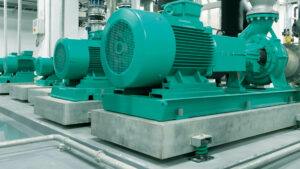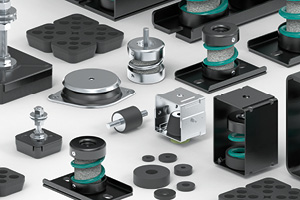The operation of mechanical and electrical (M&E) equipment and services generates varying degrees of noise and vibration which, if left untreated, have the potential to cause damage to the equipment itself as well as disturb occupants within a building. Vibration isolation is the process of isolating an object, such as a piece of equipment, from the source of vibrations.
Before we investigate and share examples of how vibration can be prevented, let’s take a look at the definition and the side effects of vibration.
 In simple terms, vibration is a mechanical phenomenon where oscillations occur about an equilibrium point. These vibrations can resonate through equipment, fixings and the building structure to create undesirable noise and discomfort for the building occupants. In the HVAC industry, most sound or noise is generated via rotating equipment and air and fluid movement through ducts and pipes.
In simple terms, vibration is a mechanical phenomenon where oscillations occur about an equilibrium point. These vibrations can resonate through equipment, fixings and the building structure to create undesirable noise and discomfort for the building occupants. In the HVAC industry, most sound or noise is generated via rotating equipment and air and fluid movement through ducts and pipes.
Unresolved vibration can cause problems affecting both the equipment itself, the building and its users. Recurring vibrations can cause:
These issues are why vibration isolation is so important.
 HVAC equipment that is rigidly attached to a slab, wall, or ceiling can transmit vibration into the supporting structure and cause highly undesirable levels of structure-borne noise. This noise can travel far and can even spread throughout the building. Alongside the HVAC equipment, the M&E services such as pipework, conduits, and ductwork can also act as transmitters of structure-borne noise if they are rigidly connected to vibrating equipment. In an HVAC system, each vibration has the potential to travel and amplify along miles of ducting or pipework. Not only does that make any vibration more of a problem – it also makes it harder to track the source.
HVAC equipment that is rigidly attached to a slab, wall, or ceiling can transmit vibration into the supporting structure and cause highly undesirable levels of structure-borne noise. This noise can travel far and can even spread throughout the building. Alongside the HVAC equipment, the M&E services such as pipework, conduits, and ductwork can also act as transmitters of structure-borne noise if they are rigidly connected to vibrating equipment. In an HVAC system, each vibration has the potential to travel and amplify along miles of ducting or pipework. Not only does that make any vibration more of a problem – it also makes it harder to track the source.
Vibration isolation is the key to solving the problem! Isolating the source of vibration from the supporting structure is typically the most efficient approach to eliminate vibration. Carefully selected vibroacoustic isolators need to be placed, where possible, directly in between the mounting structure and the equipment that produces unwanted vibration. The isolators can then effectively absorb up to 99% of excess vibration produced by the equipment.
 Products that are used to deal with vibration in HVAC equipment and services include anti-vibration mounts, spring hangers, rubber mounts and rubber sound absorbers. Products can be made of rubber, steel or a combination of both. When the machine is being used, the mounts absorb and dampen vibration, significantly minimising the impact of vibration, such as noise. Read our blog about ‘Types of Anti-Vibration Mounts’.
Products that are used to deal with vibration in HVAC equipment and services include anti-vibration mounts, spring hangers, rubber mounts and rubber sound absorbers. Products can be made of rubber, steel or a combination of both. When the machine is being used, the mounts absorb and dampen vibration, significantly minimising the impact of vibration, such as noise. Read our blog about ‘Types of Anti-Vibration Mounts’.
It is worth noting that correcting a noise or vibration problem in the future can be more difficult and costly than tackling it at the time of installation of the equipment. The cost of correction can include the time required to coordinate the investigation, direct payments to the retrofitting contractor and possible compensation paid to the building users affected. Therefore, it is always advisable to prevent any vibration issues occurring in the first place. The negligible extra cost for prevention (usually about 1% to 2% of the total HVAC system cost) is money well spent compared to the challenges and costs of correcting a problematic situation.
Walraven has an extensive range of solutions for dealing with vibration in HVAC installations. Products include:
Find out more about dealing with vibration in HVAC installations or browse our anti-vibration product range.
Dealing with vibration in HVAC installations